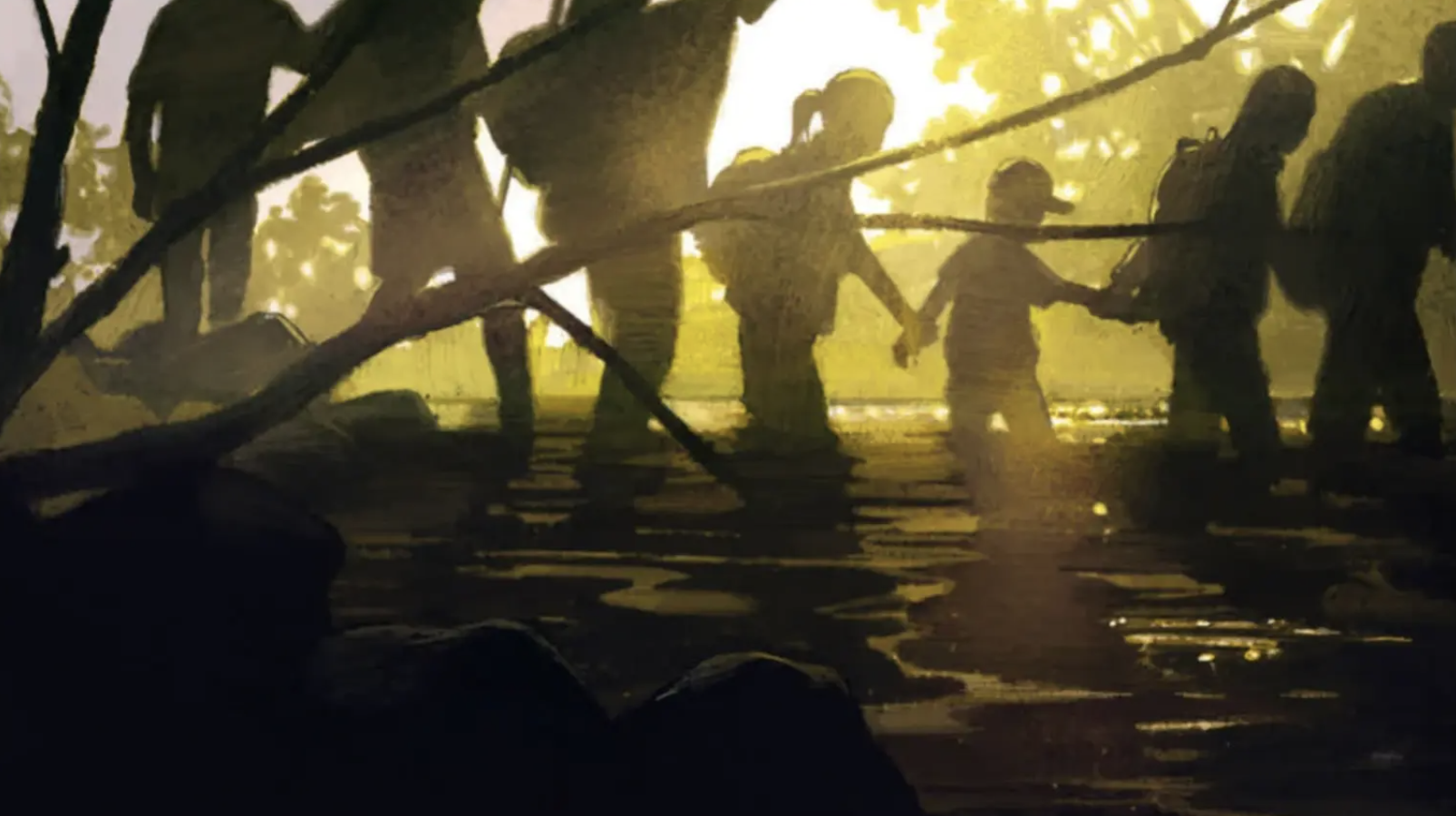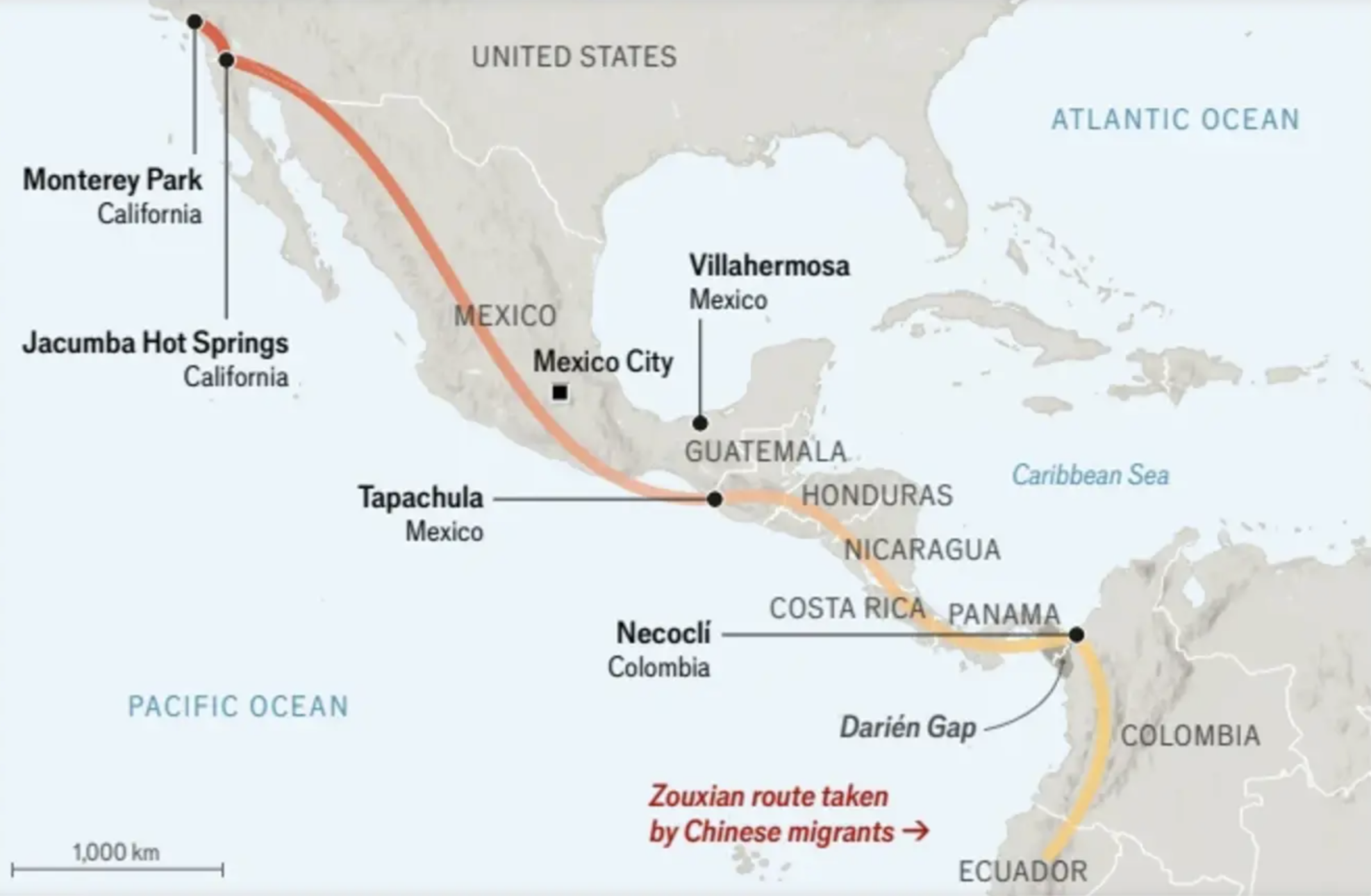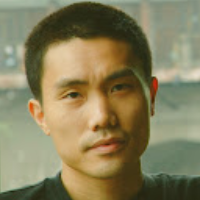We travel with Chinese migrants on the deadly journey to America's border
Migrant Caravans . lmmigration . Society . Asian Politics . Politics . Americas . United States of America . China A LONG THE ZOUXIAN ROUTE
Source: The economist

THEY COME for different reasons. Some are seeking economic opportunity. Others are disillusioned with Xi Jinping's rule. Many have seen videos of other Chinese migrants trekking across the jungle between Colombia and Panama on their way to a better lifeTens of thousands of Chinese citizens have travelled to South America, the first step on a perilous journey to the United States. The route is so popular that it has earned a Chinese nickname: zou xian, or walking the line.
For the past two years Chinese migrants have been the fastest-growing group crossing the southern border of the United States. More than 37,000 of them were encountered by the US Border Patrol in 2023, up from 3,813 in 2022 and 689 in 2021. Another 21,000 came in the first eight months of this year. They remain a fraction of the 2m migrants who tried to cross the frontier in 2023. But because America and China are locked in economic, ideological and geostrategic competition, the Chinese migrants are a political lightning rod.
To hear Donald Trump tell it, the newcomers from China are mostly men of military age “Are they trying to build a little army in our country?" he has asked.Other Republicans have Called the migrants potential spies. Kamala Harris and the Democrats are less alarmist, but they worry about the border, too. Amid a presidential campaign where immigration is a top concern and China a convenient villain, there has been little effort to understand what is driving this movement of people and what it says about each country.
 The Economist spent three months reporting in Colombia,Mexico and the United States.We interviewed dozens of migrants, as well as smugglers and border guards. Several people allowed us to track their zouxian journeys. Some reached the United States after weeks of travelling by boat, bus, foot and plane. Others lost everything along the way. Most were drawn by the promise of a better future and hoped to exploit America's broken immigration system. Their journeys also shine a light on China, where the stifling rule of Mr Xi and a worsening economic malaise are pushing people away.
The Economist spent three months reporting in Colombia,Mexico and the United States.We interviewed dozens of migrants, as well as smugglers and border guards. Several people allowed us to track their zouxian journeys. Some reached the United States after weeks of travelling by boat, bus, foot and plane. Others lost everything along the way. Most were drawn by the promise of a better future and hoped to exploit America's broken immigration system. Their journeys also shine a light on China, where the stifling rule of Mr Xi and a worsening economic malaise are pushing people away.
For many Chinese migrants the first stop in the Americas is Ecuador, which until recently offered them visa-free entry.But they quickly move to Colombia. That is where we met Ms Huang, a woman in her 40s who wore a bright pink dress. She had already defied the conservative norms of her birthplace, a poor village in the south-western Chinese province of Guizhou. Most women from the village spend their lives farming and raising children.Ms Huang, though had left for bigger towns, raised two children and divorced a husband who gambled too much.
She had come to Necoclí, a town on the edge of the Caribbean, and was about to enter the treacherous jungles of the Darién Gap between Colombia and Panama. Her younger sisters, both in their 20s, had come too. Neither of them had been outside China before
They knew little about the dangers ahead but dreamed of reaching America, said Ms Huang. Since the pandemic her employer, a grocery-delivery service, had cut her wages and increased her hours. She had seen the videos of other Chinese migrants successfully making the journey. “You only live once, right?”
Many of the migrants we met in Necoclí were motivated by economics. Back home they felt like the ladders to a better life were disappearing. A years-long crisis In China's property sector has left consumers depressed and threatened deflation. The government's recent stimulus measures have led to a stock market rally, but pessimism over the economy lingers. Ordinary Chinese once felt that with enough hard work they could get ahead. But according to new research, they now believe that being well-connected and growing up rich are the keys to success.“In China, for people in the lower-income class...there's just no way out,”said Ms Huang.
Amid this malaise Mr Xi and the Communist Party have tightened their control over society, ramping up censorship and cracking down on critics Some of the migrants we talked to in Necoclí were desperate to escape this oppression. Ah Gan and Ah Zhen, a couple in their 40s from southern China, had brought their 12-year-old son and ten-year-old daughter to the town They were sick of living in an“information cocoon’ and wanted their children to have more freedom, said Ah Gan.
Similar thoughts propel Sam Lu, a 36 year-old from Wuhan who said he had been threatened by the police in China after criticising the government's handling of covid-19 in 2020. Mr Lu caught the virus early on, while the authorities were denying its severity, then infected grandmother, who died.Standing at the ferry station in Necoclí, where migrants were wrapping their belongings in garbage bags before boarding boats for the Darién Gap, Mr Lu said he had sold his apartment pay for the trip. china's government was no longer allowing its citizens to speak he would rather die on the road America than continue living that way, he said.
Death is a real risk in the Darién Gap, one of the most dangerous stretches of wilderness in the world. Migrants pay smugglers managed by the Gulf clan, a drug traffic king cartel, for passage through part of the jungle. They face steep mountains, roiling rivers and the threat of armed bandits. More than 300 migrants have died or gone missing in the gap since 2022, according to the International Organisation for Migration, a UN body. Médecins Sans Frontières, a humanitarian group, treated nearly 700 victims of sexual violence there, many of them children, in 2023.
Despite the dangers, more than half a million migrants crossed the Darién Gap in 2023, double the number in 2022, according to the authorities in Panama.Another 238,185 have crossed so far this year. Chinese migrants are the fourth largest group making the trek(behind those from Venezuela Colombia and Ecuador). Their numbers jumped from only 2,000 in 2022 to more than 25,000 in 2023.
Chinese migrants have an easier time than others because they can afford “VIP packages" that shorten their time in the jungle. In Necoclí migrants and smugglers described three options: a $300 package that is all on foot and takes at least a week; one for $700 that is two days on foot and two days by boat; and a $1,500 trip by horse that is meant to take just a day.Smugglers take photos of the migrants at various stations and post them on WeChat, a social media platform, to prove that they are delivered safely.Most of the Chinese migrants we spoke to chose the $700 package. After exiting the jungle they took buses through Panama, Costa Rica,Nicaragua, Honduras and Guatemala, all the way to Mexico.
Many Chinese migrants said the hardest part of their journey was in Mexico. Under pressure from the United States to reduce the numbers of migrants, Mexico has implemented a policy that aims to exhaust them. They are rounded up by the authorities and dumped in the cities ofTapachula and Villahermosa in southern Mexico, far away from the United States. Some migrants have been picked up and moved several times. That strategy, along with new restrictions in the UnitedStates, led to a 77% decline in the US Border Patrol's encounters with migrants trying to cross the southern border in August compared with last December, when they peaked.
Migrants stranded in Mexico have become targets for smugglers and organised crime. The Chinese, in particular, are preyed on because they tend to have more money. While trying to cross Mexico, Ah Gan and Ah Zhen were abandoned by a group of fellow migrants, then forced by a smuggler to pay the group's debts. Later they were locked in a motel room and swindled out of more money by smugglers who claimed it would pay for bribes at check-points. The couple escaped by telling their captors that they needed to go to a nearby town to buy shoes for their children.Then they ran away to Mexico City.
The Chinese government has said that it is working with other countries to crack down on human-smuggling. But potential migrants seem more interested in other policy changes along the zouxian route. On July 1st, for example,Ecuador suspended visa-free entry for Chinese citizens. As a result, the number of Chinese crossing the Darién Gap dropped from more than 1,000 in June to 53 in August. In online discussion groups in China, those thinking about making the journey have begun looking for other entry points, such as Bolivia (where Chinese travellers can get a visa on arrival) or Suriname (where they don't need a visa).
In Tapachula a Chinese migrant named Chen was anxious about the path ahead.In June the administration ofJoe Biden made it more difficult for those who enter the United States without permission to seek asylum and remain in the country, a common approach. In July, two months after the United States and China agreed to resume co-operation on migration issues, America sent 116 Chinese citizens home on the first large deportation flight since 2018.“ The policies are all changing," said Ms Chen. “All I care about is hurrying up, moving forward, going faster."
Chinese migrants who make it to Mexico's northern frontier must navigate America's border wall. Here they have options, too. Some climb over with the help of smugglers ladders. Others find areas where the wall turns into a fence and cut a hole in it. In more rugged areas, the wall becomes nothing more than a wire which can be walked under or around with a bit of athletic skill, usually at night As the sun comes up, successful migrants walk through the sand in the direction of Jacumba Hot Springs, a town with fewer than 1,000 residents in southern California.
Once in the United States, migrants look for the Border Patrol in order to turn themselves in and apply for asylum. They are then taken for processing at a detention centre.America's asylum law allows anyone who is present in the country to apply for protection if they are at risk of persecution. The first step is often a “credible fear’ screening that is meant to assess whether they are afraid of returning to their home country. Migrants who fail are put on a deportation list and detained for up to six months. But many are then released until the government can convince China to take them back, something it has been reluctant to do until recently.
Those who pass the initial screening are given a date for a hearing and released. Chinese applicants were granted asylum 55% of the time in the 12 months to October 2023,
according to the Justice Department. But the department is thought to have a backlog of more than a million cases, including more than 32,000 involving Chinese migrants. On average, asylum seekers wait more than three and a half years for their hearings. In the meantime, they can stay in the United States. After six months, they can obtain a work permit.
Some residents of Jacumba Hot Springs are not happy about the situation. Kali Kai Braun, the caretaker of a shooting club near the border, said he had seen smugglers’ trucks drop off migrants almost every day since mid-2023.The Economist witnessed dozens of them running across the club's grounds. Mr Braun is convinced that many of the Chinese migrants are not legitimate asylum-seekers. He had painted “Fuck you, Chinese Communist Party* in Mandarin on a stone lion. It was a message, he said, to Chinese soldiers or spies.
There is no evidence that China is sending an army to America, as Mr Trump claims. A more valid complaint is that many Chinese asylum-seekers are actually economic migrants.Mei Zhou, an immigration lawyer in Los Angeles, says she has met plenty of Chinese who fabricate stories of persecution. That hurts genuine asylum-seekers. Immigration judges who encounter too many “'fake storytellers”become more cynical and reject those who really do need protection, she says.

No regrets
Many Chinese migrants settle in Monterey Park, a suburb of Los Angeles. Its Fatty DingPlaza is famous on social media as a one-stop-shop for all of a new arrival's needs. The run-down strip mall has restaurants, places to buy SIM cards and hotels offering rooms for as little as $15 a night. Most importantly, it has job agencies offering work in warehouses and on construction sites. There is no need for a work permit. But migrants can expect to earn below the minimum wage.
One calling himself Tom (after his favourite actor, TomCruise) says he has tried three jobs in the 40 days since he arrived in the United StatesHis latest gig, as an assistant mechanic, pays $100 a day for 12 hours of labour with no breaks. Still, Tom does not regret coming to America. “As long as you work hard, you will have opportunities," he says“In China, you won't have opportunities even if you work hard.”
Ah Gan and Ah Zhen feel similarly. They made it from MexicoCity to Tijuana, where they hired a smuggler to get them and their two children across the border. In August they arrived in California, three months after they had left China-and much poorer than when they began. When we met them in September they were renting a small home in San Jose. As they waited for their asylum hearing, Ah Zhen delivered parcels, an informal job she found through a Chinese app. They were trying to place their children in a local school. All four said the trip was “worth it”.
Of all the migrants 'The Economist met on the road, only a handful made it to the United States. The three Huang sisters stayed in touch from June until mid-July, when they said they were heading to 'Tijuana. Then they stopped responding. Mr Lu, the young man from Wuhan, crossed the border, according to a friend who said they were detained together on the American side. But Mr Lu has yet to be released.
In some ways what is happening resembles the situation a little over a century ago, when the forerunner of America's Border Patrol was founded.Early on, its inspectors mainly pursued migrants from China who were seeking to circumvent the Chinese Exclusion Act the first significant restriction on immigration into the United States. Back then, too, the journey from China to America was dangerous and expensive But the migrants believed they would find a better life on theother side.
The big difference is that China is no longer a poor, unstable country, as it was back then.Today it boasts cutting-edge research labs, powerful armed forces and the second-largest economy in the world. China's rise to superpower status has filled its leaders with confidence. For years Mr Xi has declared that the East is rising and the West is declining. He claims that China's economic and political systems are superior to those of America and its allies.
What, then, to make of the thousands of Chinese leaving the country for America? Their decisions reflect a calculation about the zouxian route: that, while dangerous, it is manageable, owing to the accumulated knowledge of previous migrants, the industry that has sprung up around it and the porousness of America's southern border. But in plenty of cases their choice to leave is also an indictment of Mr Xi's rule. Along the path to America, many Chinese migrants spoke of unfulfilled ambition.They had given up on theChinese dream. Now they wanted to see what America had to offer."

